The Making of a Dynasty, Part 2
Last week, I started talking about the design story of Kamigawa: Neon Dynasty, introduced you to the Exploratory and Vision Design teams, and showed off two cool preview cards. Today, I'm going to tell the rest of the design story, have Dave Humpherys introduce his Set Design team, and show off another cool preview card.
More Names in Neon
As is the tradition, I like to have the lead of the team introduce the members of their team. I'll be doing the introduction of Dave, and the rest of the bios are written by him.
Click here to meet the NEO Set Design team
Dave Humpherys (lead set designer)
I first met Dave on the Pro Tour where he was known as one of the more methodical pros. Dave's games were never fast because Dave was always careful to think through each decision. Dave would go on to be inducted into the Pro Tour Hall of Fame and eventually came to work at Wizards where he employed his same methodical methods to make Magic sets.
I have worked with Dave on numerous sets (Amonkhet, Unstable, Dominaria, War of the Spark, and Ikoria: Lair of Behemoths are the sets where both of us led one portion of the set), and it's always a pleasure. I love watching him take my ideas and those of my Vision Design teams (of which he's always a member) and make them better. Kamigawa: Neon Dynasty is no exception. I was very proud of what we handed over to Set Design, and Dave just took that vision and improved upon it, making the set I'm previewing today.
The rest of these bios are written by Dave:
Jadine Klomparens
Jadine is excellent at looking at a set in the context of surrounding sets while also looking at how things will mesh in the set itself. She's strong in revisiting mechanics that we've seemingly settled on and finding ways to improve on them. I trust her on a wide range of questions relating to balance and fun, and she's great in collaborating on cards.
Daniel Holt
Daniel was so very excited to be revisiting Kamigawa. He brought a ton knowledge of the plane and passion for the project. He helped me coordinate with Emily Teng, the creative lead for the set, on many topics that came up in meetings and bring those to a resolution. He brought a strong perspective in helping us deliver for the fans of our original exploration of Kamigawa.
Ari Nieh
Ari is exceptional in clever card designs. She had focused on how to improve on the handoff process from vision design to set design. Beyond that work, she was crucial in helping to clarify vision design goals as we explored new territory in set design. Ari also provided plenty of ideas and info for achieving color pie goals as they evolved.
Andrew Brown
Andrew, as the lead of balance for play design, brings that strength to any team. I appreciate that he brings a wealth of new card designs that he's set aside and is eager to share. Andrew has a good eye toward making sure cards haven't lost their way and that each of our cards find a home. Andrew is great to collaborate with and finds the best solutions to minimize risk while maintaining the excitement on each card.
Yoni Skolnik
Yoni, at times, looks tireless to me in how thoroughly he explores concepts in each set. He's honed those skills as a set design lead of late, most recently with Strixhaven: School of Mages. I was eager to see what mechanics or combinations of mechanics he'd bring extra scrutiny to and what roads he would lead us down as we explored possible pitfalls and rooms for improvement early in set design. I also appreciate that Yoni brings designs that tend to have particularly novel play patterns.
Reggie Valk
Reggie has a good appreciation and understanding of many of our various Constructed formats. He has a sense of what will be appealing mechanically to players who gravitate to formats we test and discuss less. Reggie is excellent at collaborating on cards and finding changes to help cards better tell their story.
Lukas Litzsinger
Lukas brings a fresh perspective to teams since he's often looking at Magic through a different lens working on other expressions and aspects of the brand. Beyond offering novel takes on individual card designs, he provided many insights on where the set and cards could do better to deliver on expectations for someone less entrenched in our current process.
Ben Hayes
Ben was a valuable reality check on me late in the process. His previous design lead experience and his generally thoughtful approach to design was a good means to check that all the pieces were coming together in a coherent fashion. Ben is good at asking the right questions and having thorough conversations about other possible options or areas to improve card designs.
Koichiro Maki
Maki was invaluable to the creation of this set. With the help of Yuki Fujii translating and providing her own perspectives in the process, we gained access to a lot of designs and opinions from our Tokyo office during critical time points in putting together the set. Maki and Yuki helped me understand much better what would and wouldn't resonate or feel appropriate with a Japanese audience. Maki provided images, designs, and references for what he and others in the Tokyo office would like to see represented on cards. He also made file pass reviews as it progressed to make sure we were staying on target.
Something Old, Something New
If we wanted this to be a return to Kamigawa, we needed to explore what mechanical call backs we could do. The big challenge is that the original Champions of Kamigawa block was a disappointment mechanically, so there wasn't a lot to salvage. Here's what we had to work with:
Bushido (When this creature blocks or becomes blocked, it gets +1/+1 until end of turn.)
As mechanics from the block go, bushido is one of the better ones in that it's simple and plays well. Its biggest problem is that it just isn't something we wanted to put on a lot of creatures. Also, its thematic tie to Samurai added some complications. In the end, we decided we could write it out on a card or two, but we didn't want to bring back the whole keyword.
Flip cards (Cards with two states that can flip from one state to the other.)
The biggest strike against flip cards is that we've figured out how to do them better with transforming double-faced cards (TDFCs). Flip cards were both considered aesthetically unpleasing and caused confusion about which version they were, especially when tapped, both problems solved by TDFCs. As you will see below, we did find a way to bring transformation to Kamigawa.
Soulshift (When this creature dies, you may return target Spirit card with mana value N or less from your graveyard to your hand.)
Champions of Kamigawa block was about a war between Humans and Spirits, so it made a lot of sense to have a Spirit tribal mechanic to represent one side of the conflict. While Kamigawa: Neon Dynasty would have some Spirits, we didn't really want a tribal Spirit mechanic.
Spiritcraft (Whenever you cast a Spirit or Arcane spell)
Spiritcraft was the other Spirit tribal mechanic, although unnamed. Its reference to Arcane, something not in the set (more on this in a second), further made this a bad fit for Kamigawa: Neon Dynasty.
Splice onto Arcane (As you cast an Arcane spell, you may reveal this card from your hand and pay its splice cost. If you do, add this card's effects to that spell.)
I've talked in articles about how I wish this had been splice on instant or sorcery to make it less parasitic. We experimented with splice onto instants or sorceries as the Izzet mechanic in Guilds of Ravnica, but we weren't that happy with how it played, so that soured its return here.
Arcane (An instant and sorcery subtype)
One of the rules in design is that we don't use subtypes on anything other than creatures if it's not mechanically relevant in the set. That meant we wouldn't use Arcane unless there was a mechanical reason for it. Obviously, we didn't use splice, but we did talk about finding a different reason to use it, but nothing ended up in the file that made sense being Arcane.
Ninjutsu ({MANA COST}, Return an unblocked attacker you control to hand: Put this card onto the battlefield from your hand tapped and attacking.)
Ninjutsu is the most popular mechanic from the Champions of Kamigawa block and the only one to have been used in a non-Kamigawa set. Interestingly, the original plan was for it not to appear in the set but for us to make a Ninja Commander deck that had a bunch of new ninjutsu cards. The idea was that it allowed us to make some other cool top-down Ninja cards that weren't always about being sneaky when attacking. During set design, Dave decided to pull it back into the set because everyone expected it to be there.
[CREATURE TYPE] Offering (You may cast this card any time you could cast an instant by sacrificing a [CREATURE TYPE] and paying the difference in mana costs between this and the sacrificed [CREATURE TYPE]. Mana cost includes color.)
This mechanic was only on a rare cycle in Betrayers of Kamigawa. It was tribal and a bit tricky to design.
Channel ([MANA COST], Discard this card: [EFFECT])
I feel the same way about channel that I do about kicker. The mechanic is a little too broad. It probably would have been better not to make something so general and instead make a lot of smaller mechanics in those mechanics' outline. That said, channel is a perfectly fine mechanic that plays well.
Epic (For the rest of the game, you can't cast spells. At the beginning of each of your upkeeps, copy this spell except for its epic ability.)
Brian Tinsman designed epic in his quest to make something that felt like a legendary spell. It was a rare cycle in Saviors of Kamigawa, and it wasn't received well. "For the rest of the game, you can't play spells" proved to be a bit too much of a downside for most players.
Sweep (Return any number of [BASIC LAND TYPE] you control to their owner's hand.)
This was a weird ability word linking together four cards that all bounced numerous lands as an additional cost. It was done as part of the Saviors of Kamigawa wisdom theme (more on this below). This mechanic often shows up on worst mechanics of all-time Top 10 lists.
Wisdom (Hand size matters)
The main mechanic theme to Saviors of Kamigawa was "hand size matters." Wisdom was the informal nickname given to it. It didn't really tie into the Japanese flavor and wasn't all that synergistic with the other mechanics in the block. I do think it's a theme we might be able to use in the right set (although it has a lot of challenges), but it's not a great fit in Kamigawa.
When the dust settled, there weren't many viable mechanics to bring back. We ended up choosing channel and ninjutsu (and even that was originally planned for the Ninja Commander deck).
Channel was both functional and practical as it allowed us to put spells on artifacts and enchantments to helps bring up the as-fans of those two card types. As you'll see in a second, we also created a transformational mechanic that we felt had a little of the flip card vibe to it. Instead of bringing back a lot of named mechanics, we decided to bring back a few of the high-profile cycles (Dragon Spirits and Shrines) and do a lot of one-of call backs (one of which is my preview card today; I'll show it off soon).
Playing Both Sides
I explained last week that we based the design around the conflict of modernity versus tradition, and that the modern side would focus on artifacts and the traditional side would focus on enchantments. This meant each side would have artifact creatures or enchantment creatures respectively, would make use of various cards of that card type, and would have cards that mechanically cared about that card type. To help focus on the two sides, I wanted each to have its own mechanic. The modern one should show up on artifacts, and the traditional one should show up on enchantments.
Interestingly, the modernity mechanic came about because we were trying to solve a different problem. The world really wanted a lot of Vehicles and Equipment, but we were running out of slots for them. Was there any way to put Equipment into creature slots? Well, what if they were also creatures?
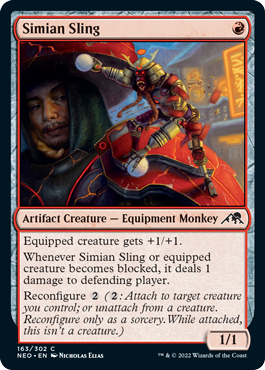
Magic had done something like this all the way back in the very first set I led the design for, Tempest. It had a mechanic called Licids.
Licids were creatures that could activate to turn into creature enchantments. What if we tried the same thing but had them turn into Equipment rather than Auras? We had learned from Licids that we didn't want the activations to be too inexpensive. We playtested it, and it worked well.
The solution for the traditional side also came from answering a different question. The traditional side was about the past and enchantments. That really sounded like a perfect home for Sagas. We had a whole block of cards and stories to reference. The big question was, did we want to do something different with these Sagas or did we simply want more straightforward "vanilla" Sagas? Again, we had a crunch in the non-creature slots, so we asked, could these be creatures? What if we made Sagas that were also creatures? That didn't seem very enticing. You didn't want players attacking with them while getting effects and have the creatures go away when the effects stopped.
That's when we came up with the idea of having the final chapter create a creature token that was thematically tied to the Saga. We had the creature token be an enchantment creature to play into the enchantment synergies.
This then led to us asking, did we have to make a token? Could the Saga turn into a creature? We tried that, and it seemed fun. It also felt like it was tapping a little into the transformation that the flip cards had done in the original block. True, they had been creatures that turned into enchantments (well, at least in Saviors of Kamigawa), but the reverse didn't feel too far off. In the handoff from vision design, we suggested a tweaked frame with a single face, but the double-faced versions were just far cooler and easier to use, so the Set Design team made that change.
My preview card today is one of these "Saga Creatures." As with all of them in the set, we use the story of the Saga to call back to stories and characters from the original block. My preview is a call back to my favorite design from Champions of Kamigawa.
Click here to see Fable of the Mirror-Breaker
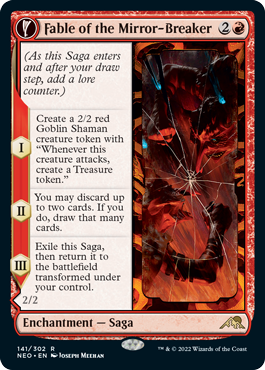
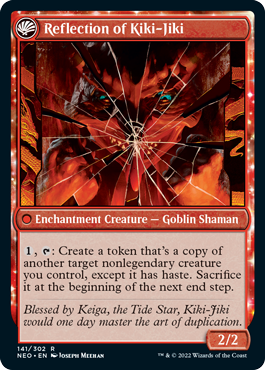
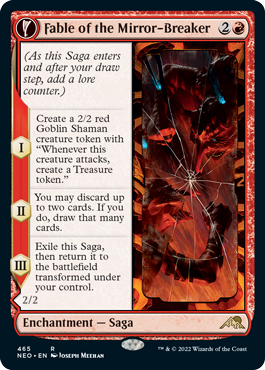
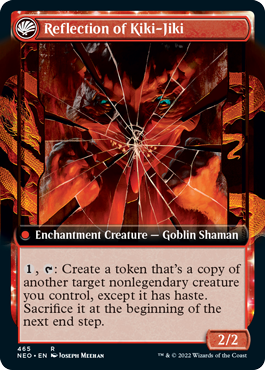
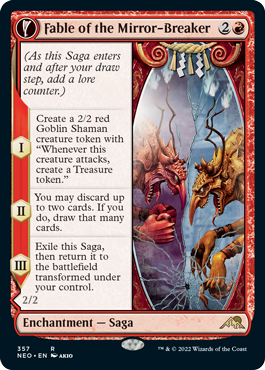
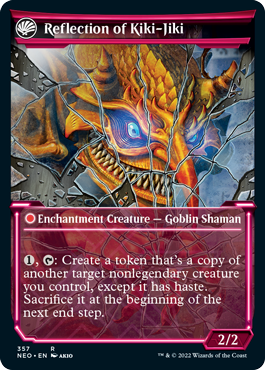
Yes, it's Kiki-Jiki. I designed the original Kiki-Jiki, Mirror Breaker back in Champions of Kamigawa to make a red creature that could copy things. I'm so happy he gets a call back in Kamigawa: Neon Dynasty.
Once we had a mechanic for each side, we made one for the middle. During vision design, we called it harmony (it ended up going unnamed in the set), and it required you to have both an artifact and an enchantment. This would enable some decks that played a combination of both sides. We focused it in white and black as a draft archetype.
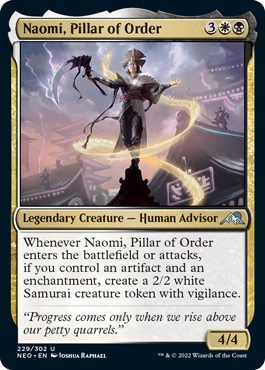
The final mechanic we added was something we wanted to be useful to both sides. We ended up using a mechanic we had originally designed for Kaldheim. The mechanic, modified, took advantage of the fact that both sides made use of things that went on creatures (Equipment and Auras; we would later add counters). Modified took advantage of the mechanical similarities of artifacts and enchantments which did a nice job of tying the component pieces of the set together and allowed another series of decks that could mix and match the sides. The mechanic was focused in red and green as a draft archetype.
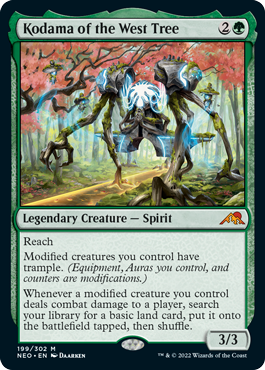
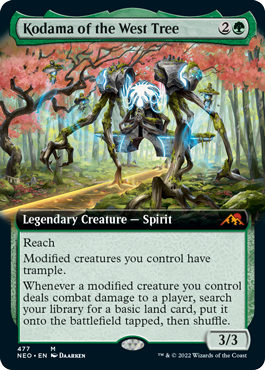
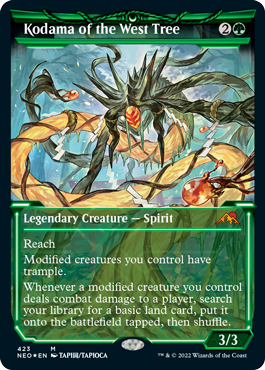
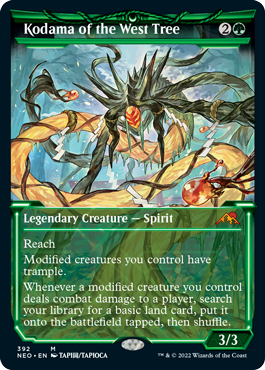
Just My Type
While that's all the mechanics, there were two more themes we added during vision design. Every set likes to have a little bit of tribal-ness to it, and Champions of Kamigawa block had taught us there were two tribes that players enjoyed building around most: Samurai and Ninjas.
The one problem was that none of the sets around Kamigawa: Neon Dynasty would have either of those two creature types, so we ended up pairing each one with a class creature type that sees more print. Samurai was paired with Warrior, and Ninja was paired with Rogue. This would allow you to build decks in both Limited and Constructed. While we let each creature type show up in more colors than in Champions of Kamigawa block, we focused each of them in the two colors they were best known for (red and white for Samurai, and blue and black for Ninjas).
Return to Kamigawa
That's all the time I have for today. As you can see, there's a lot packed into Kamigawa: Neon Dynasty, so I can't wait for all of you to get a chance to play with it. As always, I'm eager to hear your thoughts on today's column, on any of the mechanics I discussed, or on Kamigawa: Neon Dynasty itself. You can email me or contact me through any of my social media accounts (Twitter, Tumblr, Instagram, and TikTok).
Join me next week when I show you the vision design handoff document for Kamigawa: Neon Dynasty.
Until then, may you discover the part of Kamigawa: Neon Dynasty that most speaks to you.
#901: Casual Play with Melissa DeTora
#901: Casual Play with Melissa DeTora
I sit down with Designer Melissa DeTora to talk about the new casual play design group she's leading.
#902: Champions of Kamigawa Block Mechanics
#902: Champions of Kamigawa Block Mechanics
In this podcast, I take a look at all the named mechanics from the Champions of Kamigawa block.
- Episode 900 R&D Vocabulary, Part 4
- Episode 899 Templating with Matt Tabak
- Episode 898 2017

